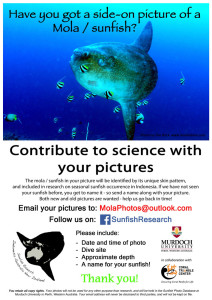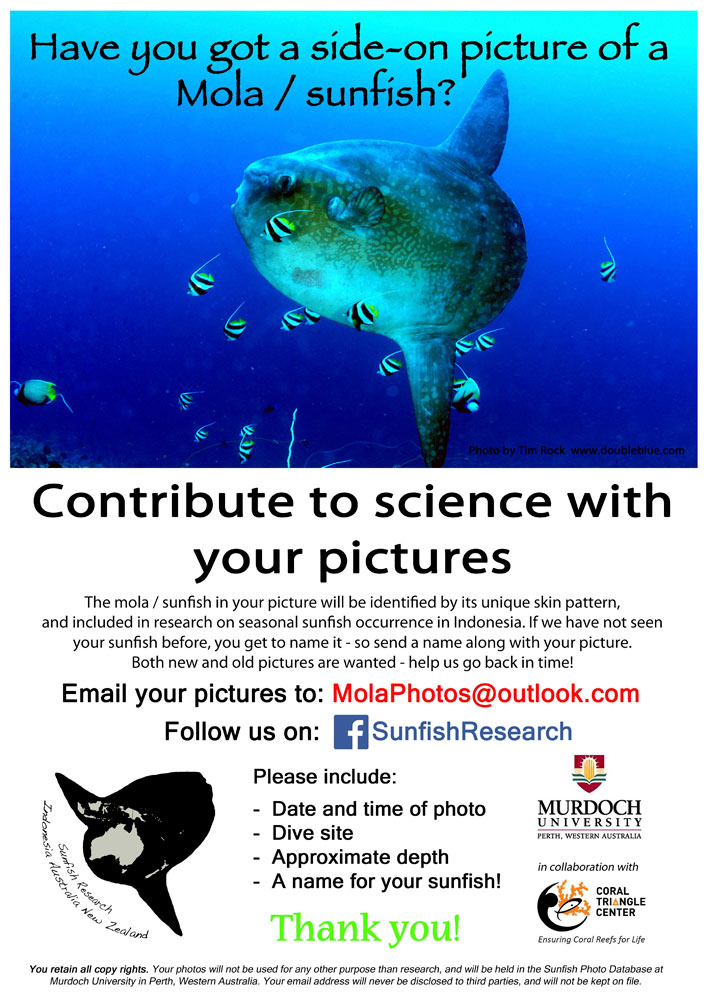 The large, odd and somewhat rare ocean sunfish (or mola mola) is getting a real boost from a new research program based in Perth, Australia. A new identification program is now officially underway to try to find out more about the sunfish that make seasonal visits to the reefs of Bali in west-central Indonesia. It will include naming, identifying and hopefully tracking their annual return.
The large, odd and somewhat rare ocean sunfish (or mola mola) is getting a real boost from a new research program based in Perth, Australia. A new identification program is now officially underway to try to find out more about the sunfish that make seasonal visits to the reefs of Bali in west-central Indonesia. It will include naming, identifying and hopefully tracking their annual return.
For a bit of history, in the mid-1990s, the phenomenon of ocean sunfish visiting the island of Nusa Lembongan, near Bali, Indonesia, was largely a rumor. Occasionally seen by surfers at Nusa Lembongan’s famous “Shipwreck Reef ” break, they were thought to be very large sharks.
Then, Aquaquest Micronesia TV producer Tim Rock traveled through Bali. As author of Bali’s first diving guidebook, Rock already knew the quality and diversity of Bali’s diving better than most. However, nothing had prepared him for meeting the marine aliens of Nusa Lembongan; the mola molas. Many friendships and collaborations followed. With the help of Bali-based dive operator Michael Cortenbach of Bali Dive Academy, his crew was to capture the first ever TV footage of the ocean sunfish aggregation, eventually drawing the attention of many other high profile presenters, producers, scientists and conservationists to this incredible seasonal natural phenomenon.
This became an annual collaboration for Rock and Cortenbach. During a photo shoot of a benefit book for the Bali bombing victims in 2003, Rock found himself diving solo off nearby Nusa Penida. As Rock dropped through the water, an interstellar marine mother ship appeared, being serviced by numerous tiny marine mechanics; it was a giant mola mola. It was patiently hovering at a cleaning station, letting a cloud of reef fish pick off its skin parasites. Rock watched in fascination, and then captured the Sunfish Research poster image.
Kicking off the new research project, he has named that sunfish Asri for its beauty and harmony with nature. It is also the name of his granddaughter.
Now, your photos can also help science and you can give your sunny recognition. You, too, can name your sunfish through this new research project.
Using a method well established for whale sharks and manta rays, marine biologist Marianne Nyegaard, of Murdoch University in Perth, is identifying individual molas based on their unique skin patterns.
Supported by the Coral Triangle Center, and as part of her PhD, she will use photos taken by visiting divers and Indonesia residents to enable her to recognize individual molas. She wants to find out if the same individuals come back to visit the islands year after year. In support of her research, she is extending an appeal for your mola images, new and old, to cover ground and go back in time.
To help out, please email your mola photos to: MolaPhotos@outlook.com
The higher the resolution of the image, the better. Please include the date and time taken and dive site. All copyrights will be respected, and submitted photos will never be reproduced or circulated. Participants are welcome to put a watermark on the images. They will be used for scientific research only. Nyegaard is hoping for worldwide submissions of molas photographed not only in Lembongan but also anywhere in Indonesia.
And of course Rock will be back in Bali sometime this season adding to his already considerable collection of mola mages, supported by Cortenbach and Bali Diving Academy, who continue to bring this unique experience to divers and photographers alike.
To follow the progress of the research, go to Facebook: SunfishResearch
For the sunfish story see Tim’s Blog:
http://www.guammicronesiadivetravel.com/travelblog1/?p=1735
To try a mola dive, see Michael’s website:
For more on the Coral Triangle Center:
http://coraltrianglecenter.org/







